Determining how often to sterilize baby bottles for newborns can be confusing at first. Between feedings, pumping sessions, and sleepless nights, it’s easy to lose track of what’s been cleaned and what hasn’t. This guide simplifies everything—explaining when and how to sterilize, the safest methods to use, and time-saving ways to keep bottles hygienic without overcomplicating your routine.
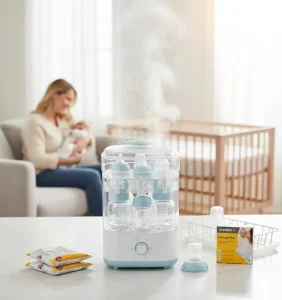
Why Sterilizing Baby Bottles Matters
During the first few months, a baby’s immune system is still developing. Even small amounts of bacteria can cause digestive issues or infections. According to the American Academy of Pediatrics, sterilizing bottles during early infancy can reduce gastrointestinal illness by up to 70%.
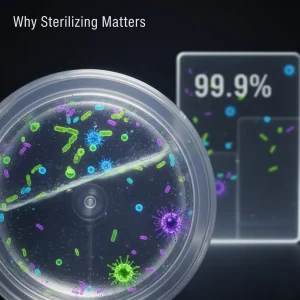
Milk residue, formula, and even tap water can harbor germs invisible to the eye. Sterilizing ensures 99.9% of harmful bacteria and viruses are eliminated—something standard washing cannot always achieve.
How Often Should You Sterilize Baby Bottles for Newborns?
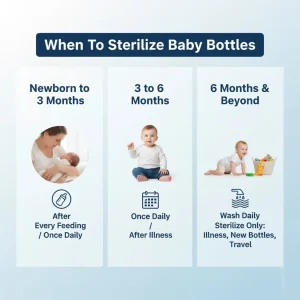
Newborn to 3 Months
Sterilize bottles after every feeding or at least once daily.
This is the most important stage since your baby’s immune system is still maturing. Whether using formula or pumped milk, each bottle should be sterilized before use.
3 to 6 Months
Sterilize bottles once a day or after your baby has been ill.
At this stage, your baby’s immune system becomes stronger, but a daily sterilizing routine remains beneficial.
6 Months and Beyond
While your baby starts exploring, crawling, and putting objects in their mouth, daily sterilizing becomes less critical. Thorough washing with hot, soapy water is generally sufficient.
Sterilize only:
- After illness (such as colds or stomach infections)
- When using new bottles for the first time
- After travel or when the water quality is uncertain
Note: Premature infants or those with specific health needs may require extended sterilizing periods. Always consult your pediatrician for guidance.
When Extra Sterilizing Is Necessary
Even beyond the newborn phase, certain situations call for additional sterilizing:
- After your baby has been sick
- When using bottles for the first time
- Following travel or exposure to questionable water sources
- If a bottle has been left unrefrigerated for more than two hours.
These are the precautionary steps to ensure safety and maintain hygiene.
Best Ways to Sterilize Baby Bottles
Modern parents have several effective methods for sterilizing bottles. Each has its pros and cons depending on lifestyle and equipment availability.
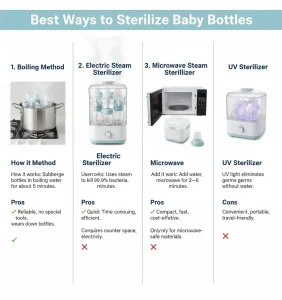
1. Boiling Method
How it works: Submerge bottles in boiling water for about 5 minutes.
Pros: Reliable and requires no special tools.
Cons: Time-consuming and can wear down bottles over time.
2. Electric Steam Sterilizer
How it works: It uses steam to kill 99.9% of bacteria in minutes.
Pros: Quick, automatic, and efficient.
Cons: Requires counter space and electricity.
3. Microwave Steam Sterilizer
How it works: Add water and microwave for 2–6 minutes.
Pros: Compact, fast, and cost-effective.
Cons: Only suitable for microwave-safe materials.
4. UV Sterilizer
How it works: It uses UV light to eliminate germs without water or chemicals.
Pros: Convenient, portable, and ideal for travel.
Cons: Higher initial cost.
Cleaning vs. Sterilizing: What’s the Difference?
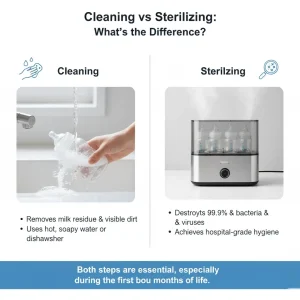 Both serve different purposes.
Both serve different purposes.
Cleaning removes milk residue and visible dirt using hot, soapy water or a dishwasher.
Sterilizing destroys microscopic bacteria and viruses that cleaning might miss.
Both steps are essential, especially during the first few months of life.
Step-by-Step Baby Bottle Sterilizing Routine
- Wash First—Rinse bottles with warm, soapy water to remove any residue.
- Choose a Sterilizing Method—Boil, steam, or use UV sterilization depending on your setup.
- Dry and Store Safely—Air-dry bottles on a clean rack or keep them sealed in the sterilizer if it has a storage feature.
Tip: Keep a small set of sterilized bottles ready in advance to avoid late-night cleaning sessions.
Expert Tips for Easier Sterilizing
- Use distilled water in steam sterilizers to prevent mineral buildup.
- Rotate between 5–6 bottles to reduce workload.
- Choose a sterilizer with an auto shut-off feature to simplify the process.
FAQ
Cleaning & Washing
Do I need to wash bottles before sterilizing?
Yes. Always wash bottles, nipples, and rings thoroughly before sterilizing. Sterilizers work best on clean surfaces.
Can I use regular dish soap?
Yes, as long as it’s mild and fragrance-free. A baby-safe bottle wash is ideal but not essential.
Can I use a dishwasher for baby bottles?
Yes. If your dishwasher has a sanitize or hot dry cycle, it can clean and sterilize simultaneously. Use a mesh basket for smaller parts.
Sterilizing Frequency and Methods
How often should you sterilize bottles for newborns?
For infants under three months, sterilize after each feeding or at least once daily.
For three to six months, sterilize daily or after illness. But after six months, washing with hot water is typically sufficient, with occasional sterilizing after travel or sickness.
Do formula-fed babies need more frequent sterilizing?
Yes. Formula can encourage bacterial growth; therefore, daily sterilization is recommended in the first few months.
Can filtered or bottled water replace sterilizing?
No. Germs can still come from milk residue, bottle parts, or hands.
Is boiling safe for plastic bottles?
Yes, if they are BPA-free and labeled “boil safe.” Limit boiling to five minutes to avoid damage.
Do I need to sterilize after every night feeding?
Ideally, yes, but if that’s impractical, wash with hot soapy water and sterilize all bottles together in the morning.
Storage and Safety Guidelines
How long do bottles stay sterile?
Most sterilized bottles remain germ-free for up to 24 hours if kept sealed.
How should bottles be stored?
Allow them to air-dry completely, then store in a sterilizer, closed cabinet, or sealed container. Avoid open surfaces.
Can I dry bottles with a towel?
Not recommended, as towels can transfer bacteria or lint. Air drying is safest.
Can bottles be over-sterilized?
Daily sterilizing is safe, but repeated heat exposure can wear down plastic. Replace bottles and nipples every 3–6 months or when cracks appear.
Troubleshooting and Time-Saving Tips
Why are bottles turning cloudy after sterilizing?
This is likely mineral buildup from hard water. Try to use distilled water or soak bottles weekly in a 1:1 vinegar-water solution.
My sterilizer has white residue—what should I do?
Clean it with a vinegar solution and run an empty cycle.
Do glass bottles need sterilizing?
Yes. Germs can grow on any material, so sterilize glass bottles just like plastic ones.
Expert Advice: When to Stop Sterilizing
Boiling is effective; however, modern sterilizers save time and ensure consistent results. Steam or UV sterilizers can eliminate bacteria in as little as six minutes—ideal for busy parents.
Most families stop sterilizing around 12 months, once the baby’s immune system is more mature and solid foods are introduced. Until then, sterilizing remains one of the simplest ways to safeguard your baby’s health.
Final Takeaway
While sterilizing bottles may seem repetitive, it’s a vital step in protecting your newborn from illness.
- For babies 0–3 months, sterilize after every use or at least once daily.
- For babies 3–6 months, sterilize once daily.
- After 6 months, regular washing is typically enough, with sterilizing after illness or travel.
With modern sterilizing tools, the process is faster and more convenient than ever. Keeping bottles clean doesn’t have to be overwhelming—it’s simply a small routine that delivers peace of mind and helps ensure your baby stays healthy and happy.